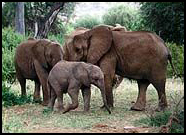Between 1979 and 1989, the worldwide demand for ivory caused elephant populations to decline to dangerously low levels. During this time period, poachings fueled by ivory sales cut Africa’s elephant population in half. Since they were big targets and sported the largest tusks, savannah elephants took the worst hit. But as soon as these elephants began to vanish, hunters moved into the forests in search of the elephants’ smaller kin. In 1977, 1.3 million elephants lived in Africa; by 1997, only 600,000 remained.
Recently, that number has stabilized, due in large part to the 1990 Convention on International Trade in Endangered Species (CITES) ban on international ivory sales.
But in June, 1997, CITES voted partially to lift trade sanctions and to allow Zimbabwe, Botswana, and Namibia to sell stockpiled ivory to Japan, where there is a major ivory market. Many conservation groups fear that this slight loosening of the ivory ban will rekindle poaching throughout the elephants’ range.
Even though it is illegal to kill an elephant in Africa, people continue to slaughter the mammoth beasts — if not for ivory, then for revenge. Whether forest or savannah dwellers, roaming elephant herds have begun butting up against sprawling human populations in most regions. While Masai herdsmen coexist with elephants by leaving their livestock unfenced and letting the animals walk through their land, farmers who try to barricade their crops from migrating wildlife create trouble for themselves. To a farmer, an elephant can be an irritating five-ton garden pest — or an active danger to his life. If a hungry beast destroys the season’s crop, the culprit (or sometimes just the nearest elephant, guilty or not) may be hunted down and forced to pay the price of the damage with its life.
Scientists are working on remedies to suit both parties. One has developed a pepper-spray bomb that wards off elephants by attacking their sensitive eyes with airborne pepper molecules. The elephant recovers soon after, having learned to stay clear of the fields.
Still, elephant poaching remains a problem in some parts of Africa. In September, 1996, Michael Fay, an elephant researcher with the Wildlife Conservation Society, was flying his small airplane over a remote forest clearing just outside the Nouabale-Ndoki National Park in northern Congo when he spotted a cluster of elephant carcasses. Deciding to investigate further, Fay returned the next day by helicopter, accompanied by a television camera crew.
Fay, who had worked with Cynthia Moss and the African Wildlife Foundation to help establish the park in 1993, found a scene of slaughter: there lay more than 300 elephant bodies, all with their tusks hacked off. Cows, calves, and juveniles had been indiscriminately left to die by poachers supplying the illegal ivory trade. Two months later, Fay found the remains of 1,000 more dead elephants nearby.
Taking action into his own hands, Fay chased poachers out of the forest by destroying their camps. He also met with the local village leaders to solicit their help in ending the killings. By the spring of 1997, Fay and his colleagues had stopped illegal hunting of elephants in the Nouabale-Ndoki region. He and Andrea Turkalo, another researcher for the Wildlife Conservation Society, continue to monitor and protect elephants in the Congo basin.
As urban sprawl continues to block migration routes in and out of these protected areas, elephants rely on the open corridors provided by traditional Masai land use. Dr. David Western, director of the Kenya Wildlife Service, believes the best way to alleviate human-wildlife conflicts is to give people a reason to keep the local wildlife alive and healthy. For instance, eco-tourism in Amboseli National Park and its neighbor Nairobi National Park puts money directly back into the local Masai communities. Rather than a burden, the elephants become an important part of the local economy.
Photos: Diane C. Ross.









